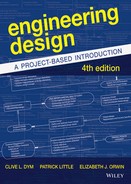FOREWORD*
To design is to imagine and specify things that don't exist, usually with the aim of bringing them into the world. The “things” may be tangible—machines and buildings and bridges; they may be procedures—the plans for a marketing scheme or an organization or a manufacturing process, or for solving a scientific research problem by experiment; they may be works of art—paintings or music or sculpture. Virtually every professional activity has a large component of design, although usually combined with the tasks of bringing the designed things into the real world.
Design has been regarded as an art, rather than a science. A science proceeds by laws, which can sometimes even be written in mathematical form. It tells you how things must be, what constraints they must satisfy. An art proceeds by heuristic, rules of thumb, and “intuition” to search for new things that meet certain goals, and at the same time meet the constraints of reality, the laws of the relevant underlying sciences. No gravity shields; no perpetual motion machines.
For many years after World War II, science was steadily replacing design in the engineering college curricula, for we knew how to teach science in an academically respectable, that is, rigorous and formal, way. We did not think we knew how to teach an art. Consequently, the drawing board disappeared from the engineering laboratory—if, indeed, a laboratory remained. Now we have the beginnings—more than the beginnings, a solid core—of a science of design.
One of the great gifts of the modern computer has been to illuminate for us the nature of design, to strip away the mystery from heuristics and intuition. The computer is a machine that is capable of doing design work, but in order to learn how to use it for design, an undertaking still under way, we have to understand what the design process is.
We know a good deal, in a quite systematic way, about the rules of thumb that enable very selective searches through enormous spaces. We know that “intuition” is our old friend “recognition,” enabled by training and experience through which we acquire a great collection of familiar patterns that can be recognized when they appear in our problem situations. Once recognized, these patterns lead us to the knowledge stored in our memories. With this understanding of the design process in hand, we have been able to reintroduce design into the curriculum in a way that satisfies our need for rigor, for understanding what we are doing and why.
One of the authors of this book is among the leaders in creating this science of design and showing both how it can be taught to students of engineering and how it can be implemented in computers that can share with human designers the tasks of carrying out the design process. The other is leading the charge to integrate the management sciences into both engineering education and the successful conduct of engineering design projects. This book thus represents a marriage of the sciences of design and of management. The science of design continues to move rapidly forward, deepening our understanding and enlarging our opportunities for human-machine collaboration. The study of design has joined the study of the other sciences as one of the exciting intellectual adventures of the present and coming decades.
Herbert A. Simon
Carnegie Mellon University
Pittsburgh, Pennsylvania
August 6, 1998
* Herb Simon graciously contributed the foreword for our first edition. Unfortunately, the passage of time since was marked by the loss of one of our great heroes and a true renaissance mind: Herb passed away on March 4, 2002. We still feel the loss.
